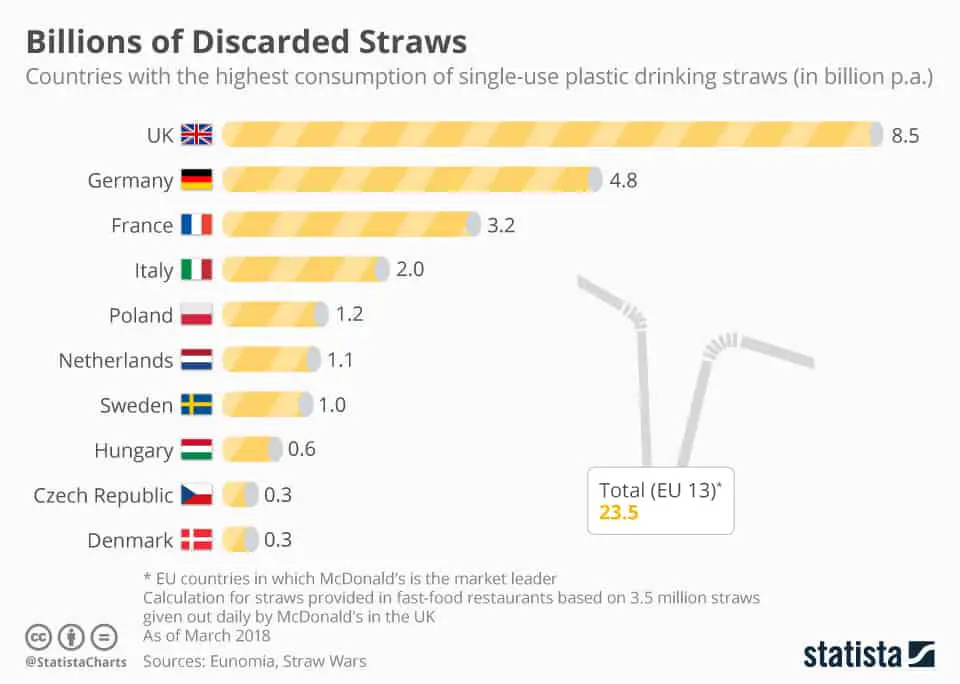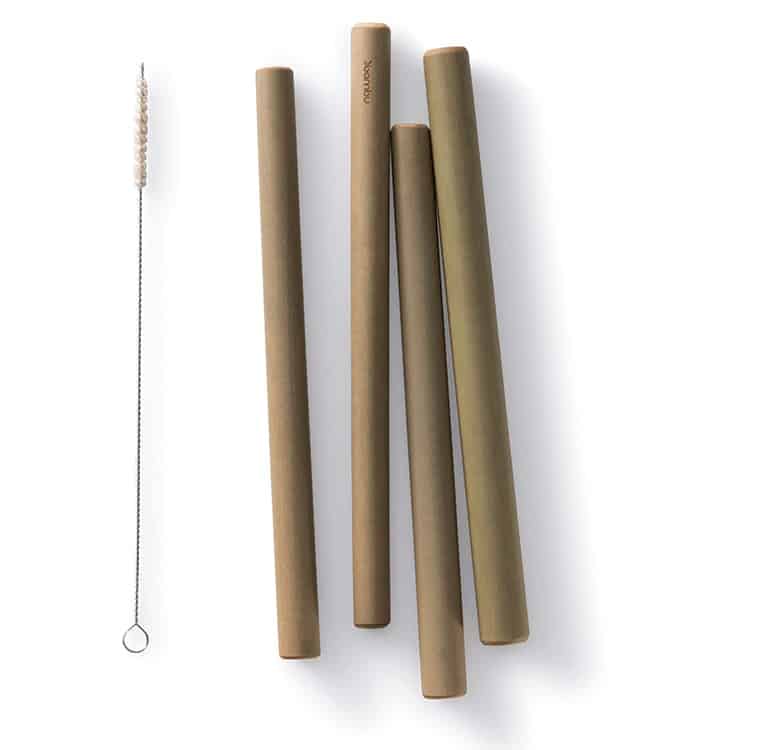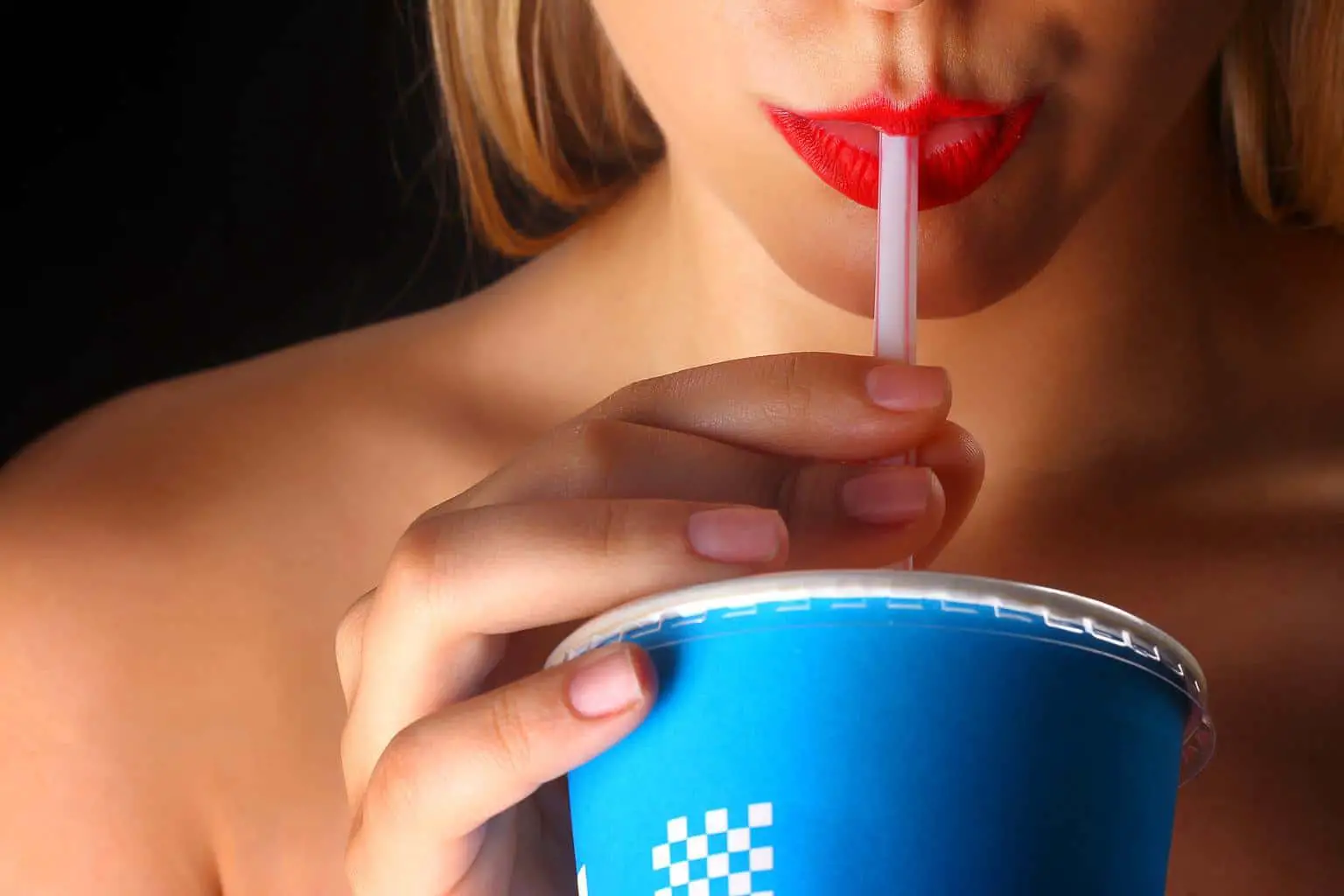Do you live in a city or region that has banned – or is planning to ban – plastic straw use?
We’re used to seeing these seemingly innocuous plastic devices everywhere – in bins next to fountain drink dispensers, in restaurants, and in our grocery stores.
Yet, these straws and other plastic debris are literally choking our oceans and threatening to do lasting damage to our environment.
To combat this threat, your town, too, may be thinking about instating a plastic straw ban.
But even without the requiring legislation, you can do your part to curtail the use of single-use plastics by adopting eco-friendly alternatives to plastic straws.
Plastic Straw Pollution In Our Oceans
National Geographic reported that in the U.S., about 500 million straws are used every single day. The report also asserted that as many as 8.3 billion (!) straws pollute beaches all around the world each year.
As it turns out, the situation in Europe is no different.
McDonald’s alone distributes 23.5 billion drinking straws each year – and that study only included 13 European countries:

Even with pushes to recycle and properly dispose of our plastic items, these materials are winding up in our oceans and other watercourses where they are disrupting marine life and significantly damaging the planet.
The following video shows how much damage, pain and suffering one single plastic straw can cause (warning: contains distressing footage, so watch at your own discretion):
Long-Term Damage Caused By Plastic Straws
Although some types of plastic straws are recyclable, it’s important to note that many are not. And as we’ve just learned, most of them end up polluting our environment anyway. Moreover, plastics never actually biodegrade.
Instead, as plastic items disintegrate, they simply break down into tiny particles known as microplastics that linger in our oceans, landfills, and beaches forevermore.
When those micro-particles wind up in fish and plants that we consume, the result can be quite toxic, and how that affects humans long term is something that will require substantial study.
Of the 8.3 billion metric tons of plastic that have been produced around the world since the 1950s, about 60 percent of it is accumulating in our natural environment, according to a report by USA Today.
Without halting aspects of plastic waste like single-use items, the pollution will continue to impact the planet. In a given year, McDonald’s alone makes about 1.35 billion in revenue from sales of soft drinks.
These beverages are offered with an accompanying straw; that’s a lot of plastic – and that’s just one fast-food chain. When single-use plastics like straws are suspended, some level of recovery is possible.
Recovering From Plastic Straw Pollution
All over the world, there are a number of cleanup and anti-pollution campaigns taking place. Environmental groups are campaigning hard to put an end to single-plastic use.
Legislators in major cities like Seattle are introducing legislation that bans plastic straw use. Companies like Starbucks, Hyatt, and McDonald’s are planning to phase out their plastic straw use globally.
Major ocean cleanup initiatives spearheaded by companies like The Ocean Cleanup (see solution 13. in this article) are committed to removing the trillions of pieces of garbage floating in our oceans today – before they turn into microplastics.
Yet, even with these initiatives in process, plastic straw use is still an active and pressing pollution problem.
Environmentally Friendly Straws
If you want to switch from plastic straws to eco-friendly alternatives, you basically have the choice between two main categories: reusable straws or biodegradable single-use straws.
Let’s take a look at some great options currently on the market.
Paper Straws
Marvin Chester Stone. Ever heard of him? Most people have not and, yet, this Union Army Civil War veteran’s simple invention, the paper straw, could help save today’s plastic-ridden oceans.
Before this American inventor created the world’s first straws, people relied on natural straws of ryegrass for sipping, but the grass imparted an unpleasant taste.
Stone’s 1888 invention became a popularly used device, but then plastics came along and, as we are learning, are contributing to the ailing health of our environment.
Yet, for fast-food chains, restaurants, and other purveyors of fountain drinks, the most likely alternative to plastic straws are paper straws, Stone’s 19th century innovative invention.
One of the barriers to their large-scale adoption is cost. A single plastic straw costs about a half cent, while a paper straw will cost 2.5 cents, according to a report by CNBC.
Paper straws require a more intensive manufacturing process than plastic straws, owing to the need to glue multiple layers together in order to ensure that the paper can withstand liquids without losing its integrity. Many companies are making plans to switch to paper straws, but most have not abandoned their plastics yet.
Even so, while the big companies are waiting to make the switch to paper, individual consumers do have some viable options available. Some great paper straw products to consider purchasing for use at home include:
Aardvark Straws
Aardvark Straws produces various types of responsible paper straws that are made in America. The company features bendable straws, cocktail straws, giant straws, custom straws, and more.
The straws have been tested and are approved by the FDA, are long-lasting and durable, and are created from sustainably sourced cellulose paper – so they’re biodegradable and eco-friendly.
Kikkerland Biodegradable Paper Straws
Made with food-safe ink, Kikkerland Biodegradable Paper Straws feature a wide range of colorful patterns, from barber stripes to birch to gold and many more. They come in a box of 144.
These straws are durable; they’ll certainly hold up for one drink, but like all paper straws, they are not intended for use with multiple drinks.
Each one measures about eight inches in length and has an opening just slightly smaller than what you might expect from a typical fast-food restaurant straw.
Remember, paper straws are not reusable. They are only intended for a single use. These brands we’ve shown you here have positive reviews so you can safely opt for one of them, but you should read the reviews for other brands before purchasing to ensure that you’re getting a quality product that can hold up well for one beverage.
Bamboo Straws
While paper is the most popular option for disposable straws, other materials are used to create multiple-use straws.
Bamboo is a sustainable material that is being used to produce reusable straws. The following companies who make these straws source bamboo that is free from pesticides, dyes, or other chemicals.
One thing to keep in mind is that most bamboo straws must be washed by hand and need to be stored in a ventilated area when drying to prevent mold or mildew growth.
Bambu Reusable Bamboo Straws

Bambu produces a set of six reusable straws made from bamboo. The company uses no glue to produce these reusable straws and sells them with a convenient cleaning brush, which is also made from plant-based material (from sisal fiber).
Being a certified B-corporation, Bambu is committed to the highest standards of environmental and social responsibility. The company is also a member of 1% for the planet, which means it gives 1% of its annual sales to support environmental non-profit organizations worldwide.
The straws are 100% USDA Certified Organic and, with proper care, are designed to last for years. If you’re looking for a non-paper alternative to plastic, these bamboo straws are an excellent alternative.
Brush with Bamboo Straws
Another great option in bamboo straws is the Brush with Bamboo set of twelve. These straws are reusable, washable, and made with 100% USDA certified biobased bamboo.
This set is a bit pricier than other bamboo straws, but each straw is made entirely by hand, unlike most commercial options that are machine made.
Bali Boo Bamboo Straws
Bali Boo Bamboo Straws come in a set of twelve and are made entirely from eco-friendly, organic bamboo. They are reusable and naturally resistant to mold and rot.
These straws are easy to hand wash but they can also be washed in your dishwasher. The set includes 2 cleaning brushes that help keeping your straws clean as well as a cotton pouch that can hold about 7 straws. That’s a great way to take your straws with you wherever you go.
Metal Straws
When considering a long-term straw alternative, think about metal straws. The ideal choice is stainless steel because it’s resistant to rust and corrosion. The options here are manufactured by companies that guarantee these qualities.
Stainless steel is also a great material to come in contact with food (learn more about the pros and cons of stainless steel, glass and other materials in our article about drinking bottles).
The downside to metal straws is that it can be difficult to see inside them to ensure they’re clean. You might want to consider purchasing a set that comes with a straw cleaning brush or one that can be washed in your dishwasher.
RSVP Endurance Stainless Steel Straws
RSVP Endurance Stainless Steel Straws are created from food-grade 18/8 stainless steel. They are rust-resistant as well as resistant to scratches and breaks. They’re certainly attractive enough to present as gifts, too.
They are 8.5 inches long with a 5 mm opening and are slightly bent at the top for more convenient sipping.
To keep them clean, give them a good rinse, use a small brush or put them in your dishwasher (yes, they are dishwasher safe).
Bed Bath & Beyond Stainless Steel Drinking Straws
These straws are sold in a set of four and come with a cleaning brush for added convenience and easy cleaning.
They have a lower price point than many other options, so people looking for a budget-friendly solution may want to consider this set. They are dishwasher safe and are resistant to corrosion, rust, breaking, and staining.
Glass Straws
Glass straws are beautiful objects that are certainly gift-worthy, but it’s important to look for options that are ‘shatterproof.’ Glass straws are designed for durability, but chips and scratches are possible.
A positive feature is that glass straws come in a clear hue, which makes them easy to clean, but colored options are also available.
In general, glass is also one of the best materials to come in contact with food (learn more about why in the section about “which material” in our article about drinking bottles).
Glass straw sets come in a wide array of sizes, styles, and widths. You can use them in hot and cold beverages and they’re conveniently dishwasher safe.
Hummingbird Glass Straws
Hummingbird Glass Straws are not only shatter-resistant, but they’re also safe (even for kids), strong, and – it must be said -incredibly attractive!
Hummingbird sells sets of glass straws that include a cleaning brush. Choose from clear or colored options as well as bent or straight versions.
Simply Straws Reusable Glass Straws
Handmade in California, Simply Straws Reusable Glass Straws are available in an array of colors. These straws are hypoallergenic, use non-toxic colors and are designed for both hot and cold beverages. They are also available in various lengths for added convenience.
The company offers a “you break ’em, we replace ’em” lifetime guarantee. Each set comes with a cleaning brush as well as a sleeve which is perfect to eliminate the need for plastic straws on the go.
Strawesome Barely Bent Glass Straws
If you’re looking to replicate those bendable plastic straws that kids seem to love, consider the Strawesome Barely Bent Glass Straws that come in a set of four.
Each straw features a slight bend near the top for easy sipping. These straws are available with options; you can choose your color, length, and width. A free cleaning brush is included with your purchase.
Glass Dharma Straws
Glass Dharma Straws come in a wide variety of types. Choose from lid straws, coffee straws, iced tea straws, and even decoratively etched straws.
These glass straws come in sets of four or six and come with a cleaning brush. The straws are dishwasher safe and designed for hot and cold beverages.
Silicone Straws
Silicone Straws are soft, flexible, and definitely kid-friendly. They are also hygienic and relatively easy to keep clean.
These straws tend to be pricier than bamboo options, but they’re also less expensive on the whole than stainless steel or glass straw sets.
Available in a dazzling array of colors, silicone straws are also a great alternative to single-use plastic straws.
Softy Straws Reusable Silicone Straws
Sold in sets along with a cleaning squeegee, Softy Straws Reusable Silicone Straws are among the most popular silicone straw options on the market today.
They are made of FDA approved food grade silicone and are therefore free of any harmful chemicals.
Since the silicone material is very soft and bendable, they are especially suitable for kids. They can safely bite on them, while the material is strong enough to resist tear.
The flexibility makes it also super easy to transport them anywhere.
The fact that you can also clean them at high temperatures in your dishwasher makes it super easy to keep them hygienic.
Available in bright colors, these straws are bendy, safe, and conveniently reusable.
Conclusion
The long-term effects of plastics in our oceans and environment is multi-faceted. Marine life is already suffering from the impact as are fisheries.
Microplastics harm life so the implication that humans will suffer from this pollution is virtually undeniable.
With a useful life of only a few minutes but a lifespan of hundreds of years, plastic straws contribute significantly to this problem.
At the same time, few plastic products are as easy to avoid or replace with better alternatives as plastic straws.
By choosing an eco-friendly straw as a solution to sip your iced tea or favorite soda, you’ll be doing your part to end the damaging reign of the plastic straw.
Consider these environmentally friendly straws mentioned above and enjoy your refreshments without any plastic-infused guilt.
You Might Also Like…
- Is Fast Food Bad for the Environment? (& What You Can Do)
- Is Fabric Softener Bad for the Environment? (+5 Eco-Friendly Options)
- Is Fuel Dumping Bad for the Environment? (& How Often It Happens)
- Is Electricity Generation Bad for the Environment? (What You Should Know)
- Is Dry Cleaning Bad for the Environment? (4 Surprising Facts)
- Is Diamond Mining Bad for the Environment? (Important Facts)
- Is DEET Bad for the Environment? 4 Effects (You Should Know)
- Is Cat Litter Bad for the Environment? (5 Common Questions)
- Is Burning Cardboard Bad for the Environment? (6 Facts)
- Is Burning Paper Bad for the Environment? (6 Surprising Facts)
- Is Burning Leaves Bad for the Environment? (7 Quick Facts)
- 4 Natural Cleaners for Quartz Countertops
- 6 Eco-Friendly Acrylic Paint Brands (For Sustainable Artists)
- 5 Eco-friendly Alternatives to Acrylic Paint (& How to Make Them)
- Is Acrylic Paint Bad for the Environment? (7 Quick Facts)
- Is Acrylic Yarn Bad for the Environment? 8 Crucial Facts
- Is Acrylic Bad for the Environment? (8 Quick Facts)
- Is Aluminum Foil Bad for the Environment? 7 Quick Facts
- Is Bleach Bad for the Environment? 6 Crucial Facts
- Is Lithium Mining Bad for the Environment? 6 Crucial Facts









































